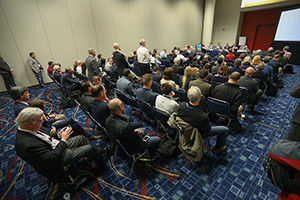
(From left) 2017 ASA President Jeffrey Plagenhoef, M.D., Past President John Zerwas, M.D. (2013), Jeffrey A. Weiss, D.O., Brian P. Woods, M.D., and Eric Mason, M.D., interact with the audience at a well-attended Tuesday session on the anesthesia care team.
Problems physician anesthesiologists encounter in implementing anesthesia care teams (ACT) came under scrutiny Tuesday when medical executives from several national and regional anesthesia practices joined 2017 ASA President Jeffrey Plagenhoef, M.D., and Past President John Zerwas, M.D. (2013), to address issues raised by anesthesiologists attending a session called “The Future of Anesthesia Care Team in the Era of Increased Competition.”
Anesthesia care teams can include anesthesiologists who act as directors of the team, anesthesiology fellows and residents, nurse anesthetists and anesthesiologist assistants.
The anesthesia care team model has been implemented by many hospitals to increase efficiency and cut costs. It is less expensive than the all-physician approach to anesthesia administration and allows anesthesiologists to be available for patient evaluations, consultations and other essential aspects of patient care.
A major focus of the discussion concerned the ratio of anesthesiologists to the number of cases being performed at one time. Medicare has a special payment policy formula for medical supervision that applies when an anesthesiologist is supervising more than four procedures concurrently.
Many anesthesiology practices maintain a supervisory ratio of one anesthesiologist to four cases. Some anesthesiologists attending the session said they find the one-to-four ratio to be a problem.

A standing-room-only crowd of diverse stakeholders shared ideas about future best practices regarding the anesthesia care team model of care.
Dr. Zerwas said that studies need to be done to determine the optimal ratio of anesthesiologists to cases. He noted that there is a big difference in competency and efficiency between a newly licensed nurse anesthetist just starting out in practice and one who is a seasoned veteran. That difference can influence how many cases an anesthesiologist is able to supervise.
“In some places, you would need roller skates to supervise four cases at one time,” he commented.
Dr. Plagenhoef said it’s important to remember that anesthesiologists, not hospital administrators, set the standard for how the anesthesiology practice is run.
“What proof do we have that one-to-four is the right number?” one anesthesiologist asked.
Jeffrey A. Weiss, D.O., President of TeamHealth Anesthesia in Palm Beach Gardens, Florida, said, “It’s not about the number but how you are allocating care on a given day. Personally, I would prefer to see a one-to-three ratio, and, if the cases are really difficult, one to two or one to one. With easy cases, you might be able to extend the ratio to one to five or one to six.”
Return to Archive Index